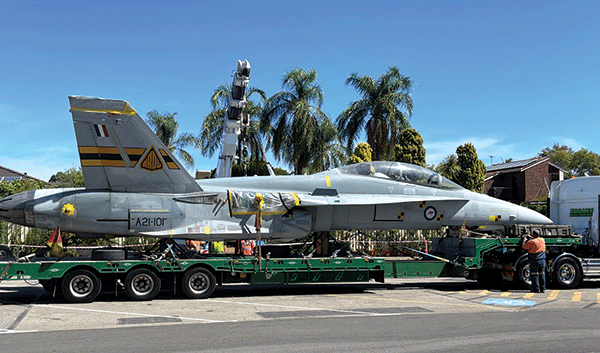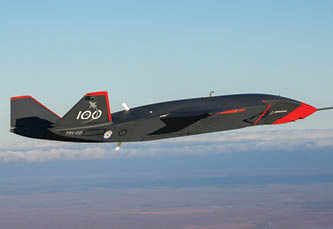by Charles Page
On 13 March 2023 components of F/A-18B Hornet, A21-101 arrived at the Aviation Heritage Museum of Western Australia, in Bullcreek. Then the following day the fuselage and its canted fins arrived by semi-trailer all the way from RAAF Williamtown. A crane hoisted the fuselage, the wheels were extended, and the aircraft maneuvered into its new hangar. Proudly displayed near the cockpit, was the name of the pilot: FLTLT A Yelland “ICE”.
Over the next month, the Hornet was reassembled by a team from Boeing’s Classic Hornet Sustainment Support (CHSS). The inner wings, outer foldable wings, tailerons, pylons, and ordnance were reattached, and the aircraft readied for the handover on 13 April 2023. RAAFA WA President Clive Robartson AM gave a stirring acceptance speech, with Head of Clear Skies, Ian Craig, relating the history of A21-101. Then after Boeing Program Manager Gail Collie summarised the various CHSS projects, the aircraft was blessed by RAAF Chaplain Squadron Leader Haydn Lea.
The RAAF ‘Classic’ F/A-18A/B Hornets were officially retired on 29 November 2021, with a ceremony at RAAF Williamtown, though it was 4 December before the last Hornet left Tindal for decommissioning. The Hornet (which gained the “Classic” prefix after the introduction of the Super Hornet) has accrued more than 408,000 flying hours in its 36 years with the RAAF, with only four lost in crashes, making it one of the safest fighters ever used by the RAAF. In stark contrast, of the 116 RAAF Mirages, 41 were lost in accidents. Of the 75 Hornets delivered, 4 were written off, 25 were sold to Canada, 8 retained for museums and display, with the balance on offer to Air USA, a private combat training company.
The F/A-18 selection process for the RAAF began after McDonnell Douglas rolled out the first F/A-18A on 13 September 1978 for the US Navy. The RAAF needed a replacement for the Mirage IIIO, and on 20 October 1981, the multi-role (hence the F/A for Fighter/Attack) Hornet was finally selected and an initial order for 75 Hornets was placed in November 1981. The order consisted of 57 single-seat F/A-18As (serial A21-1 to A21-57) and 18 two-seat F/A-18Bs (A21-101 to A21-118). The F/A-18B two-seat cockpit, required relocation of avionics equipment, and internal fuel was reduced by 6%. However, it was fully combat capable.
The Hornet was powered by two General Electric F404-GE-400 turbofans, each with 16,000 lb thrust in afterburner, giving it a maximum speed over Mach 1.8 (1,915 km/h, 1190 mph) and a ceiling over 50,000 feet. The Hornet was a rugged carrier design, weighing in at 56,000 lb (25,400 kg) fully loaded, with a wingspan of 12.39 meters (40 ft 8 in), a length of 17.06 meters (56 ft), and a height of 4.64 meters (15 ft 3 in). The RAAF Hornets retained the tail hook, but the launch bar on the nose wheel was removed, only to be later replaced by a ‘dummy bar’ to correct nose wheel shimmy.
Armament included AMRAAM and ASRAAM air to air missiles, a 20 mm M61 nose canon, Mk 82, Mk 83, Mk 84 bombs, GBU laser-guided bombs, JDAM guided bombs, cruise missiles, and Harpoon anti-ship missiles. The Hornet could also carry three drop tanks, giving it a ferry range of some 3,700 km (2300 statute miles)
The first 14 Hornets (A21-1 to A21-7, A21-101 to A21-107) were all allocated to No 2 Operational Conversion Unit (2OCU) for Hornet instructor training. A21-101 was built as a Block 14, B model Hornet in St Louis, USA. Like A21-102, it was specially wired for test and evaluation. It made its first flight on 13 August 1984 and was officially handed over to the RAAF at the MacAir plant, St Louis on 29 October 1984.
A21-101 was delivered on 9 March 1985 and arrived in Australia after a record breaking, 15-hour non-stop Trans-Pacific ferry flight from the USA on the 17 May 1985. A21-101 flew in company with A21-102, and the flight was led by the 2OCU CO, Wing Commander Brian Robinson (Robbo). The 6672nm (12,360km) flight from US Naval Air Station Lemoore, California to RAAF Williamtown, was made possible by inflight refuelling from USAF KC-10 tankers.
Meanwhile, A21-103 and A21-104 had been delivered to Avalon by a USAF C-5 Galaxy on 6 June 1984. They were reassembled by GAF (Government Aircraft Factories) and A21-103 made its first flight on 26 February 1985. The balance of the RAAF’s order was similarly reassembled by GAF.
The 57 F/A-18A Hornets were the single seat fighter version and equipped No 3 Squadron in 1985, No 77 Squadron in 1985 and No 75 Squadron in 1988. Over the years, these squadrons have been deployed for domestic event security, and overseas operations.
The Hornet Upgrade Program (HUG) began in 1999 and ran in three phases. Computer systems, navigation system and radio were replaced, and the ASRAAM air-to-air missile replaced the Sidewinder. Phase 2 included an improved radar, voice encryption, a Joint Helmet Mounted Cueing System, data link, a new countermeasures dispenser, and improved ECM. There was also a modification to enable use of the LITENING targeting pod. Phase 3 sought to repair any airframe damage, particularly in the centre fuselage.
In 2001 four Hornets took part in Operation Slipper to provide air cover for Diego Garcia, and in 2003 No 75 Squadron was based at Al Ubeid, Qatar in support of Operation Bastille, and Operation Falconer in the invasion of Iraq. No 75 Squadron was led by Wing Commander Mel Hupfield, who later became Chief of Air Force. Then from 2015 to 2017, the three Squadrons took part in Operation Okra, supporting ground forces, and attacking DAESH terrorist positions.
In August 2004, A21-101 was re-allocated to ARDU (Aircraft Research and Development Unit). ARDU plans, conducts and analyses the results of ground and flight testing of existing and new Air Force aircraft. ARDU consists of three test and evaluation flights (TEFs) located at RAAF Bases Edinburgh, Amberley, and Williamtown, staffed by qualified test pilots, flight test engineers (engineer graduates of test pilot school) and flight test system specialists (air combat officer graduates of test pilot school).
When the Classic Hornet was ordered in 1981, it gave the RAAF fighter group a vast leap in technology, with a pulse-doppler look-down radar with a shoot-down capability, an inertial navigation system, a head-up display, and the HOTAS (hands on throttle and stick). But after more than three decades of service it was superseded by the Super Hornet and the F-35A Lightning II, along with the electronic attack EA-18G Growler.
The ‘Classic’ Hornet has had a proud history and RAAFA WA is very proud and grateful to be offered A21-101 for its museum in the Air Force Memorial Estate, Bullcreek. It may seem ironic that this iconic aircraft should be retired to a retirement village, but it will be well cared for in its specially constructed hangar, and many will come to admire it and learn of its place in our military history.
Sources: ADF-Serials | Aircraft of the Royal Australian Air Force | Boeing SQNLDR Paul Falconer-West | David Spicer | Gail Collie | Wikipedia













